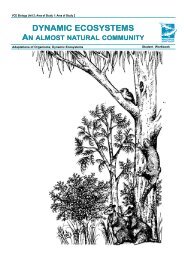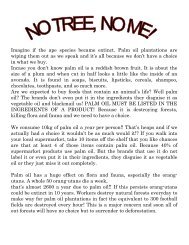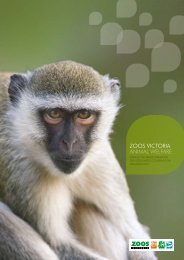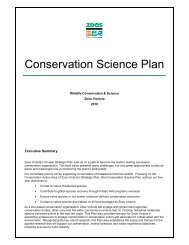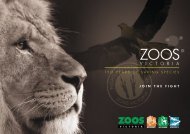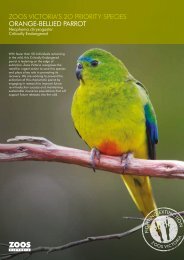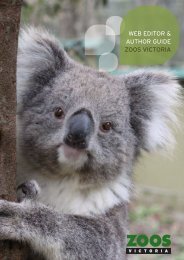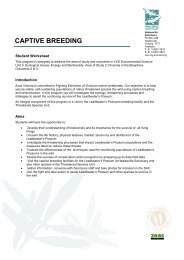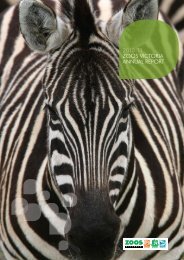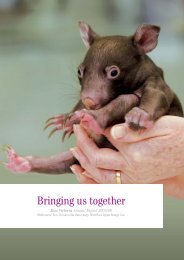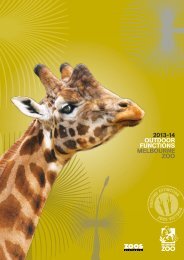ANIMAL REPRODUCTION - Zoos Victoria
ANIMAL REPRODUCTION - Zoos Victoria
ANIMAL REPRODUCTION - Zoos Victoria
Create successful ePaper yourself
Turn your PDF publications into a flip-book with our unique Google optimized e-Paper software.
<strong>ANIMAL</strong>1<strong>REPRODUCTION</strong>Eutherian MammalsHamadryas BaboonHamadryas Baboons form social hierarchies that involve the formation of troops,bands, clans and harems. A harem is the smallest unit and usually includes adominant breeding male, females and young. Bachelor groups also exist.1. What is the reproductive advantage of living in groups?2. How do females indicate their readiness to mate?3. What technology has been used to control reproduction in this group?Table of reproductive featuresSexual dimorphism:Describe (if present)Method ofattracting amateCourtshipbehaviour:Describe (ifpresent)Fertilization:Internal orexternalLive birthor egglayingNumberofyoungperlitterCare of young
Page 3Eutherian MammalsOrang-utanOrang-utans are generally solitary; however, young spend up to eight years in thecare of their mother. During this time, young orang-utans learn their survival skills,including climbing, locating and remembering food sources and avoiding predators.Male orang-utans move into areas inhabited by females for mating, then leave thefemale who raises the young.1. What is the advantage for orang- utans living a solitary life?Dewi (juvenile female) was conceived naturally in 2011, to parents Santan (male) and Maimunah(female). Dewi was their second successful reproductive event, with Menyaru (sub-adult male), bornin 2003.2. Describe some of the reproductive technologies that have been employed by MelbourneZoo to increase Maimunah’s chance of conception. Describe how the keepers preparedMaimunah for motherhood.3. Observe Maimunah’s interaction with Dewi for five- minutes, list the behaviours youobserve in the table below.Parenting BehaviourOther BehaviourTable of reproductive featuresSexualdimorphism:Describe (ifpresent)Method ofattracting amateCourtshipbehaviour:Describe (ifpresent)Fertilization:Internal orexternalLive birth oregg layingNumberof youngper litterCare of young
Page 4Palm OilWhat’s Reproduction got to do with it?The single biggest threat to the survival of orang-utans is the unsustainable production ofpalm oil. Its rampant cultivation is destroying rainforest habitat at an alarming rate. Thesimple fact is that Australian consumers can’t tell whether they are contributing to this crisisbecause palm oil is not clearly labeled on most food products – instead it is often groupedunder the misleading category of ‘vegetable oil’. Since late 2009, <strong>Zoos</strong> <strong>Victoria</strong>’s Don’t PalmUs Off campaign has advocated for the mandatory labeling of palm oil in all food products inAustralia and New Zealand.Meet Marissa…<strong>Zoos</strong> <strong>Victoria</strong> employs Reproductive Biologists whospecialize in the planning of successful reproductiveoutcomes for our endangered species. Dr MarissaParrott leads a team of specialists at <strong>Zoos</strong> <strong>Victoria</strong>.She is an example of how working as a biologist canhelp to save the world.Get involved!We are now one step closer to mandatory palm oil labeling becoming a reality with the palmoil Bill through the Senate and off to the House of Representatives for consideration. TheBill is in the hands of the politicians but you can still help ensure mandatory labeling inAustralia by writing/emailing your Federal MP and telling them you want palm oil labeled!• Write to food manufacturers asking whether they source sustainable palm oil• Purchase foods with sustainable palm oil when they are appropriately labeled• You can help make transparent labeling a reality by writing to your Federal MP, letthem know that you want the choice• Write to Food standards Australia New Zealand with your thoughts and concerns onthe issue.How is Palm Oil labeled?
Page 5Eutherian MammalsSumatran TigerCats are solitary animals, with the exception of lions that live in a social group.Female tigers care for their young for up to 18 months. Mature males live a solitarylife within an established territory. A male’s territory can overlap that of severalfemales. Female cats are induced ovulators, where the stimulation of mating isneeded for ovulation to occur.At the tiger exhibit, you may notice a range of strong smells in the area surroundingthe exhibit.1. Outline the significance of smell for solitary animals such as tigers2. Explain the reproductive advantages of territorial behaviour3. Even though Ramalon (male) and Binjai (female) were genetically suited to breed, explainwhy Melbourne Zoo kept them separated for two years before introducing them in thesame enclosure to mate.4. Describe the major threat to the Sumatran Tiger’s habitat. Explain the impact this has hadon the species and what <strong>Zoos</strong> <strong>Victoria</strong> is doing to protect them from extinction.Table of Reproductive featuresSexualdimorphism:Describe (ifpresent)Method ofattracting amateCourtshipbehaviour:Describe (ifpresent)Fertilization:Internal orexternalLive birth oregg layingNumberof youngper litterCare of young
Page 6MarsupialsWombat, PotorooMarsupials are mammals that give birth to underdeveloped young that migrate intothe pouch to complete their development.The common wombat is an ambassador animal for our Wipe 4 Wildlife Campaign.This campaign encourages the community to help save local wildlife by making the switch torecycled toilet paper and choosing products with the FSCÆ logo.1. Rather than record the birth date of marsupials, Zoo keepers take note of the date the joeylives ‘Permanently Out of the Pouch’ (the POP date). Explain reasons why this is done.Explain Marsupial diapause. Suggest the reproductive and survival advantages of thisadaptation.Table of Reproductive featuresSexualdimorphism:Describe (ifpresent)Method ofattracting a mateCourtshipbehaviour:Describe (ifpresent)Fertilization:Internal orexternalLive birth oregg layingNumberof youngper litterCare of young.
Page 7MonotremesPlatypus and EchidnaMonotremes are mammals that are oviparous or egg-laying and produce milk frommammary glands. There are only three living examples of monotremes today; theplatypus and two species of echidna1. Monotremes are said to have characteristics of eutherian, marsupial, reptileand birds. Describe how monotreme reproductive characteristics are similarto each of these groups of animals.2. Use the Venn Diagram to compare and contrast the characteristics of monotremes to othermammals.EUTHERIANMONOTREMEMARSUPIALTable of Reproductive featuresSexual dimorphism:Describe (if present)Method ofattracting amateCourtshipbehaviour:Describe (ifpresent)Fertilization:Internal orexternalLivebirth oregglayingNumberof youngper litterCare of young. I
Page 8InvertebratesStick InsectsStick Insects belong to a group called arthropods. Many arthropods have adapted toa method of reproduction called parthenogenesis. This method is defined as asexualreproduction where offspring may develop from unfertilized eggs. The developmentof unfertilized eggs allows the female to pass her DNA on to the next generation.1. Describe the sexual dimorphism of the Stick Insect species you observe, commenting onsize, shape and any differences in behaviour you observe.2. Explain the difference between asexual and sexual reproduction3. In the classroom, list the species that have adapted to the following reproductive methodsSexualAsexual4. Suggest the reproductive advantages and disadvantages of parthenogenesis (asexual reproduction).AdvantageDisadvantageDid you know some reptile populations are made up entirely of females?
Page 9Learning SpaceAnimal: Green Tree FrogSexualdimorphism:Describe (ifpresent)Method ofattracting a mateCourtshipbehaviour:Describe (ifpresent)Fertilization:Internal or externalLive birth oregg layingNumberof youngper litterCare ofyoungAnimal: Snake SpeciesSexualdimorphism:Describe (ifpresent)Method ofattracting a mateCourtshipbehaviour:Describe (ifpresent)Fertilization:Internal orexternalLive birth or egglayingNumberof youngper litterCare ofyoungAnimal: LizardSexualdimorphism:Describe (ifpresent)Method ofattracting a mateCourtshipbehaviour:Describe (ifpresent)Fertilization:Internal or externalLive birth oregg layingNumber ofyoung perlitterCare ofyoung
Page 10GlossaryFertilisationOvulationOestrusCopulationCourtshipSexual reproductionAsexual reproductionGestation periodSexual dimorphismParthenogenesisOviparousViviparousOvoviviparousthe union of the sperm and egg (gametes) as occurs in animals or plants thatreproduce sexuallythe release of the egg from the ovarythe period of fertility that usually coincides with ovulation during which a female willcopulate with malesthe act of placing sperm inside the body of the female animalthe behaviour that precedes mating; usually aimed at attracting a mateany reproduction which involves the union of the sperm and the egg, regardless ofhow the egg and sperm meetany reproduction that does not involve the union of sperm and eggthe length of time it takes for a fertilised egg to develop to birthmarked physical differences between the sexesa type of asexual reproduction found in some animals (including stick insects) whereoffspring can develop from unfertilised eggsProducing eggs that hatch outside the bodyGiving birth to living offspring that develop within the mother's bodyProducing eggs that hatch within the female's body without obtaining nourishmentfrom it




